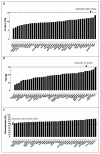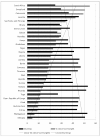Diet and mortality rates in Sub-Saharan Africa: stages in the nutrition transition
- PMID: 21995618
- PMCID: PMC3209469
- DOI: 10.1186/1471-2458-11-801
Diet and mortality rates in Sub-Saharan Africa: stages in the nutrition transition
Abstract
Background: During the last century we have seen wide-reaching changes in diet, nutritional status and life expectancy. The change in diet and physical activity patterns has become known as the nutrition transition. At any given time, a country or region within a country may be at different stages within this transition. This paper examines a range of nutrition-related indicators for countries in Sub-Saharan Africa (SSA) and attempts to develop a typical model of a country in transition.
Methods: Based on the availability of data, 40 countries in SSA were selected for analysis. Data were obtained from the World Health Organisation, Demographic and Health Surveys and the Food and Agriculture Organisation of the United Nations. Multiple linear regression analysis (MLRA) was used to explore the determinants of infant mortality. A six point score was developed to identify each country's stage in the nutrition transition.
Results: MLRA showed that underweight-for-age, protein and the percentage of exclusively breastfed infants were associated with the infant mortality rate (IMR). The majority of countries (n = 26) used in the analysis had nutrition transition scores of zero and one. Most of them had a high prevalence of infant mortality, children that were stunted or underweight-for-age, small percentages of women that were overweight and obese, and low intakes of energy, protein, and fat. Countries with the highest scores include South Africa, Ghana, Gabon, Cape Verde and Senegal which had relatively low IMRs, high levels of obesity/overweight, and low levels of underweight in women, as well as high intakes of energy and fat. These countries display classic signs of a population well established in the nutrition-related non-communicable disease phase of the nutrition transition.
Conclusions: Countries in SSA are clearly undergoing a nutrition transition. More than half of them are still in the early stage, while a few have reached a point where changes in dietary patterns are affecting health outcomes in a large portion of the population. Those in the early stage of the transition are especially important, since primordial prevention can still be introduced.
Figures
References
-
- World Health Organisation. Nutrition in transition: globalization and its impact on nutrition patterns and diet-related diseases. 2003. https://apps.who.int/nut/trans.htm
-
- Popkin BM. An overview of the nutrition transition and its health implications: the Bellagio meeting. Public Health Nutr. 2002;5:93–103. - PubMed
-
- Popkin BM. Nutritional Patterns and Transitions. Population Devel Rev. 1993;19:138–57. doi: 10.2307/2938388. - DOI
MeSH terms
Substances
LinkOut - more resources
Full Text Sources
Research Materials



